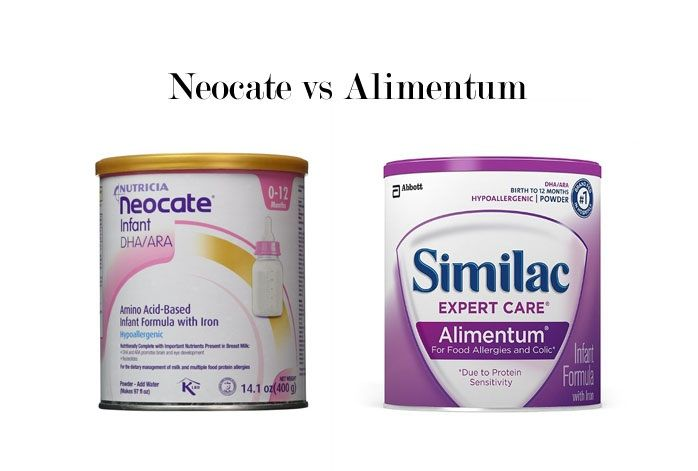Is Similac Ready to Feed Same as Powder

Similac Alimentum formula is the number one pediatrician recommended baby formula, and it comes in two forms, Similac ready to feed and Similac powder. You clicked on the right post if you are torn between the two. This article will compare Similac ready to feed vs powder.
The major difference between Similac RTF and Similac powder is the taste and price. The powder form is cheaper with a bitter taste. Also, most parents report that it makes their babies gassy and fussy. On the other hand, Similac RTF is more expensive with a great taste and fewer side effects, if not none.
In the next section, we will review both Similac ready to feed and Similac powder and give a detailed comparison. So, read on and learn.
Similac Alimentum Powder review
Similac Alimentum Powder is a hypoallergenic formula with Corn Maltodextrin as the main ingredient. It provides the baby with all the nutrients found in breast milk for proper development.
It contains DHA and ARA nutrients essential for brain and eye development.
It is lactose-free and safe for babies suffering from lactose intolerance and other related allergies.
The major downside of Similac powder is most babies reject it because it has a strong scent and smell. To make it taste better, add alcohol-free vanilla essence during preparation.
Also, it is more expensive compared to regular formula but cheaper than ready to feed Similac formula.
Pros of Similac Alimentum Powder
- Cheaper than Similac ready to feed
- Provides the baby with all necessary nutrients for development
- Allows you to decide on the thickness during preparation
- It can be sweetened by adding vanilla essence
- Safe for babies with milk protein allergy because it contains hydrolyzed milk protein
Cons of Similac Alimentum Powder
- It has a bitter taste and an awful aftertaste
- It is not suitable for babies suffering from corn allergy
- It gives the baby gassiness and makes them fussy
- Causes the baby loose yellow stool
Similac Alimentum Ready to Feed Review
Similac Alimentum RTF is hypoallergenic baby formula, especially for babies with milk protein allergies.
It does not contain corn; hence, pediatricians recommend it for babies who experience gassiness, colic, constipation, and stomach upsets after taking cow milk formula.
As the name suggests, it comes in liquid form. If you decide to feed your baby Similac RTF, you will be relieved of the formula preparation process. All you have to do is pour it into the feeding bottle. It comes in handy when you are travelling. However, some parents find it to be very thick.
Pros of Similac Alimentum ready to feed
- Convenient because it does not require preparation
- It has a sweet taste and is loved by most babies
- Made using modified tapioca starch which makes it easy to digest
- It does not contain corn; hence the best choice for babies suffering from corn allergies
Cons of Similac Alimentum ready to feed
- Very pricey
- Most parents find it very thick, and there is nothing they can do to make it runny because it is already premixed.
Read also nipples similar to similac disposable
Similarities of Similac ready to feed vs powder
- Both Similac RTF and powder are hypoallergenic formulas. This means that the proteins in the formula are broken down into tiny protein pieces. These tiny proteins are easy to digest and unlikely to cause allergic reactions.
- The formulas are formulated for babies suffering from lactose intolerance, cow milk allergy, related food allergies or colic.
- Similac RTF and powder formulas are lactose-free and contain hydrolyzed milk proteins.
- They contain all nutrients in breast milk, including DHA, ARA, and iron, among others, for healthy baby development.
Differences between Similac ready to feed vs powder
| Similac Powder | Similac ready to feed | |
| Taste | Similac powder has a strong taste and smell, and for this, it is rejected by most babies. You can, however, sweeten it up by adding vanilla essence. | Has a sweeter taste with a mild smell. Most babies love it from the word go. |
| Price | The powder is cheaper than RTF, but it is more expensive than regular baby formulas. | Similac RTF is very pricey, and you might need insurance to cover the cost. What’s more, check for coupon programs offered by Similac to cut the cost.
|
| Ingredients | Has Corn Maltodextrin as the main ingredient. It is therefore not recommended for babies with corn allergies. | It does not contain corn. It has modified tapioca starch as the main ingredient. If your baby suffers from corn allergies, this is your option. |
| Preparation | Similac powder formula requires you to mix it with water for a feed. | RTF is already premixed and does not require any form of preparation. It is very convenient when travelling. |
| Thickness | You can control the thickness level by the amount of water you add to the formula. | RTF is already mixed, and some parents find it very thick. |
| Digestion | It has been reviewed to cause gassiness and fussiness. Soy intolerance babies find it difficult to digest it. | Similac RTF contains modified tapioca starch as the main ingredient and, therefore easy on the baby’s digestive system. |
As you compare Similac ready to feed and powder, you should realize that you can only tell the best for your baby after feeding them. Just because ready to feed worked for your nephew does not mean it works for your newborn. The results are relative; therefore, keep an open mind.
To avoid disappointment, purchase a single can or bottle to see how the baby reacts to it. Also, both are high quality and effective formulas, but their differences make them different. For instance, Similac RTF is sweeter than Similac powder, but Similac powder is cheaper than RTF.
The main goal is to feed your baby with a nutritious formula easy on their delicate digestive system. Also, consult your pediatrician if you want to switch from RTF to powder or vice versa.
Read also Alimentum vs neocate
How to use Similar ready to feed formula
Similac Ready to feed is a high-quality formula, but you should only use it if your doctor recommends so. It is already premixed, and therefore, you should not add water to it, even if it appears thick.
Follow the guide below on how to use Similac RTF:
- Shake it properly before pouring it into the feeding bottle
- Open the bottle and pour enough into a feeding bottle
- Feed the baby with formula in the feeding bottle within an hour, after which discard it
- The opened formula should be refrigerated and used within 48 hours
- Store unopened bottles at room temperature away from extreme temperatures
How to prepare Similac powder formula
Correct preparation of powder formula is essential for healthy feeding. Babies can get unwell from feeding very thick or too watery formula. Follow the tips below to prepare Similac powder correctly:
Use safe and clean water- use boiled cold water to prepare the formula. Allow the water to boil for about 60 seconds and cool down completely before mixing it with the formula.
Measure carefully- it is crucial to get the powder to water ratio right for the right thickness. An overly thick or runny formula can make your baby sick. Follow the mixing guide on the packaging.
Shake the bottle thoroughly- ensure that the formula is smooth and well blended before feeding the baby. Proper mixing ensures that the baby feeds on all the nutrients in the Similac formula.
Read also Does similac alimentum cause constipation
FAQs on Similac ready to feed vs powder
Is it OK to switch from ready to feed to powder?
Yes, you can switch from ready to feed to powder formula, but you should consult with a pediatrician. Powder formula will save you some coins because it is cheaper. Because you are used to ready formula, you might find the preparation inconvenient, but it is nothing compared to the money you will save.
Is ready to feed formula better than powder for gas?
Yes, the RTF Similac formula is better for a gassy baby because it has fewer bubbles and is easy to digest. Before making the switch, please consult with a pediatrician and ensure that you are preparing the powder formula as guided.
Is liquid or powder Similac better?
Similac RTF and powder are both high-quality formulas. Your baby’s reaction after taking both determines which one is good for them. However, in terms of cost, Similac powder is better because it is cheaper, while RTF does not require preparation; hence, it is easy to use and convenient.
Read also Nutramigen sleeping problems




